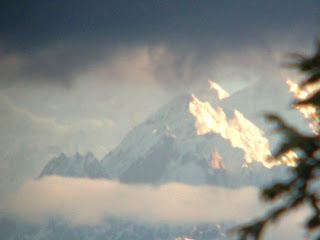.jpg) |
| Dodruchen and Chadral Rinpoche with students in Neyding, Yolmo |
I
spent several summers in a number of remote retreat centres in the mountains
north of Kathmandu. This area is directly north of the Kathmandu Valley. My
teacher, Chadral Rinpoche had a number of small retreat centres high up in the
Rhododendron forests of Helambu, in the Sindupalchok region of Nepal.
Many
in the Western world are quite unaware that such places exist and that such a
‘lifestyle’ is possible. In the nineteen nineties the living conditions were
extremely basic and often physically challenging due to the harshness of the
elements, the high altitude and many other factors that could make it a struggle
to survive.
Yet
those excursions into the mountains were among the happiest and most
interesting years of my life. Even though we were scattered around in three
different locations, the practitioners in these places all looked out for one another, this was a necessity more than a nicety. We were very much dependant upon one another.
Very often we could be
subjected to various and often unexpected ‘adventures’ many of which, demanded
that we let go of any former preconceptions or rigidity with regards to
conditions and circumstances in which to ‘practice the dharma.’
The
months spent in the mountains were a fertile ground in which one could
conceivably and with relative ease crack open not only the ‘mind’ but also the
‘heart.’
Reaching
this area at that time involved a three-day trek which began in a small
village called Melamchi Bazaar. From this little outpost, a trail wound its way
through tiny settlements along the banks of the bubbling Melamchi River.
Initially one threaded one’s way through fields of ripening rice paddy but
these soon gave way to scrub and then forest as one began to climb the hills
that rise up steeply into the Helambu region.
The
spring cum summer months usually began from late March and continued until
around the middle or end of August while from June onwards the monsoon rains
commenced. Rinpoche chose these months to visit his students in the three
locations which formed a triangle in the mountainous terrain. Neyding housed a
number of male practitioners; Tropodang was a collection of shelters for the
women and Lhakhang had both men and women practitioners living there.
Often,
while Rinpoche was visiting the centres he would teach. Therefore a handful of
the more hardy students from other places in Nepal and even further afield
would trek up in little groups to be present during these months.
By
trekking standards in Nepal, the three days walk up to the small hamlet of
Tarkygyang, the nearest village to all three centres, was a reasonably easy and
modest one. However, as most of us came there intending to make a longer stay,
we had to plan our journey and the provisions we would take up with us quite
carefully.
There was little in the way of food or supplies of any kind to be
had in this area. One also needed a tent and all the equipment required to keep
it in a relatively dry and liveable condition in the damp, high altitude
environment for many months on end. This meant that one also had to carry
tarpaulins and mats, along with food supplies, cooking utensils and all the
basic living paraphernalia needed to set up camp at high altitude.
We
faced many problems during those months. Food was scarce; the weather was misty
and often wet. The monsoon rains were preceded by tree snapping, heart-stopping
storms, which in a moment could wipe out one's entire makeshift home!
It
would take me three days to set up my camp. The ground had to be levelled and
then a trench dug all around the perimeter of the tent so that it would not be
washed away in a pre-monsoon flash flood or storm and then later in the season
be inundated by the daily monsoon downpours.
Conditions
in the retreat centres were extremely basic. Usually, they consisted of little
more than a collection of makeshift huts with a mountain stream running
somewhere nearby. The ‘huts’ in which the Lama lived were made of a framework of wooden poles; the
walls were usually only a thick black plastic. The roof was most commonly made
up of roughly hewn planks of wood. To say they were basic and flimsy was
actually an understatement.




.jpg)